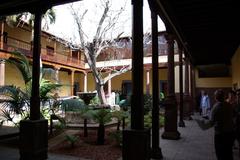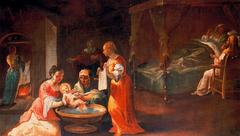Conjunto Histórico Artístico De San Cristóbal De La Laguna
Visiting the Conjunto Histórico Artístico de San Cristóbal de La Laguna: The Essential Travel Guide
Date: 14/06/2025
Introduction
San Cristóbal de La Laguna, in northern Tenerife, is a UNESCO World Heritage Site acclaimed for its trailblazing Renaissance urban planning and exceptional architectural diversity. Founded in 1497, La Laguna’s rational grid layout and harmonious design influenced cities across the Spanish colonial world. Today, its pedestrian-friendly historic center, richly adorned with religious and civil buildings from the 16th to 18th centuries, makes it one of the most rewarding destinations for anyone interested in history, architecture, and culture on the Canary Islands (Wanderlust Magazine; Everything Everywhere; patrimoniomundial.aytolalaguna.es).
This guide will help you plan your visit, providing detailed information on the city’s urban history, architectural highlights, visiting hours, ticketing, accessibility, and tips for enjoying its vibrant cultural scene.
Contents
- Historical Overview and Urban Planning
- Architectural Heritage
- Main Sights and Attractions
- Visiting Hours, Tickets, and Accessibility
- Getting There and Navigating the City
- Cultural Life and Events
- Festivals and Gastronomy
- Practical Tips and Responsible Tourism
- Frequently Asked Questions (FAQ)
- Summary and Recommendations
- Sources
Historical Overview and Urban Planning
Foundation and Development
San Cristóbal de La Laguna was founded by Alonso Fernández de Lugo in 1497, following the Castilian conquest of Tenerife. Built on a high plateau near a lagoon (drained in the 19th century), it was designed as a model city, embodying Renaissance ideals of order, harmony, and rationality. Unlike many Spanish cities of the era, La Laguna was established without fortifications, reflecting its intended role as a peaceful center for culture, religion, and administration (Wanderlust Magazine).
Renaissance Grid: Influence and Innovation
Perhaps La Laguna’s most significant legacy is its Renaissance-inspired grid plan. Streets intersect at right angles, forming a logical, navigable pattern. This design, inspired by navigation charts and mathematical principles, set the standard for colonial cities in the Americas, influencing layouts in Havana, Lima, Cartagena de Indias, and San Juan (Everything Everywhere; World Heritage Site).
The city is traditionally divided into two zones:
- Villa de Arriba (Upper Town): The earliest nucleus with an organic layout.
- Villa de Abajo (Lower Town): Laid out in 1502 according to the strict grid, representing the full Renaissance vision (The Nomadvisor).
Its fortification-free design was possible due to its inland location, minimizing threat from pirates and underscoring its status as a city of peace (Everything Everywhere).
Architectural Heritage
La Laguna’s historic center has a remarkable concentration of religious, civil, and domestic architecture, blending Gothic, Baroque, Mudéjar, and Neoclassical elements with distinct Canarian features such as wooden balconies and internal courtyards (Global Gadding).
Religious Buildings
- Cathedral of San Cristóbal de La Laguna: Originally a chapel (1511), elevated to cathedral in 1818, it features a Neoclassical façade, Neo-Gothic interior, and houses the founder’s tomb (mochileandoporelmundo.com).
- Iglesia de la Concepción: The oldest parish church, with a blend of Gothic and Baroque styles and a climbable bell tower.
- Convent of Santa Catalina de Siena: Mudéjar-style wood balconies and rich Baroque interiors.
- Church and Ex-Convent of San Agustín: Site of the island’s first university, now a cultural venue (mochileandoporelmundo.com).
Civil and Domestic Architecture
- Casa del Corregidor: One of the oldest civil buildings (1540) with a volcanic stone façade (livesharetravel.com).
- Palacio de Nava: Canarian Baroque palace with ornate stonework.
- Palacio Salazar: Rebuilt after a 2006 fire, this Baroque palace is now the Episcopal seat.
- Casa Lercaro: A 16th-century mansion housing the Museum of History and Anthropology (mochileandoporelmundo.com).
Public Spaces
- Plaza del Adelantado: The civic heart of the city, surrounded by historic buildings and a focal point for events (livesharetravel.com).
- Plaza de El Cristo: Site of the city’s main market and the Sanctuary of the Santísimo Cristo.
Main Sights and Attractions
Here are the most notable sites and their essential visitor details:
| Site | Visiting Hours | Tickets | Notes |
|---|---|---|---|
| Cathedral of San Cristóbal de La Laguna | Mon–Sat: 10:00–18:00; Sun: 13:00–18:00 | Free/donation | Main religious site; Neoclassical and Neo-Gothic features |
| Iglesia de la Concepción | Tue–Sun: 10:00–17:00 | ~€6 (combo) | Oldest church; climbable bell tower |
| Museo de Historia (Casa Lercaro) | Tue–Sat: 10:00–17:00; Sun: 10:00–14:00 | ~€4 | Museum in Renaissance mansion |
| Casa de los Capitanes Generales | Mon–Fri: 9:00–18:00; Sat: 9:00–14:00 | Free | Tourist Info Center; starting point for tours |
| Palacio de Nava | Exterior only | Free | Not open to the public inside |
| Casa Salazar | Exterior always; interior by arrangement | Free | Episcopal Palace |
| Real Santuario del Cristo de La Laguna | Daily 9:00–19:00 | Free | Important religious sanctuary |
| Plaza del Adelantado | Open 24/7 | Free | Historic city square |
Hours and ticket prices are subject to change; check official sources or the Tourist Information Office for updates.
Visiting Hours, Tickets, and Accessibility
- City Center: Open access; stroll the pedestrianized streets at any time.
- Museums/Monuments: Generally open 10:00–18:00, with some closing Mondays or for siesta.
- Tickets: Many churches and public spaces are free; museums and some sites charge €3–€6, with discounts available.
- Accessibility: The center is largely flat and walkable, but cobblestones and historic buildings may limit wheelchair access. Adapted tours are available; inquire at the Tourist Office.
- Guided Tours: Walking tours depart from Casa de los Capitanes and Calle San Agustín, covering key sites and historical context (spain.info).
Getting There and Navigating the City
- From Tenerife North Airport: 10 minutes by taxi or regular bus services.
- Parking: Limited in the center; public lots and accommodations with parking are recommended (fotografiandoviajes.com).
- On Foot: The city’s grid makes navigation simple; main streets include Calle Obispo Rey Redondo (La Carrera) and Calle San Agustín.
Cultural Life and Events
University City
The University of La Laguna (est. 1701) infuses the city with youthful energy, numerous cafés, bookstores, and cultural venues.
Theaters and Cultural Venues
- Teatro Leal: Restored early 20th-century theater hosting music, theater, and dance (aytolalaguna.es).
- Aguere Espacio Cultural: Concerts, art shows, and film screenings (taquilla.com).
Annual Festivals
- Fiesta del Cristo de La Laguna (September): Religious processions and concerts.
- Corpus Christi: Floral carpets and parades (spain.info).
- San Benito Abad Pilgrimage (July): Major folkloric event.
Gastronomy
La Laguna’s old town brims with tapas bars, cafés, and restaurants serving Canarian classics like papas arrugadas, gofio, and local seafood. Don’t miss the cake shops and bakeries for sweet treats (sendaecoway.com).
Practical Tips and Responsible Tourism
- Climate: Cooler and wetter than southern Tenerife; bring layers and rain protection.
- Safety: Generally safe; take standard precautions with valuables.
- Local Etiquette: Siesta closures in early afternoon; late dining is customary.
- Responsible Travel: Help preserve the city by respecting monuments and supporting local businesses (sendaecoway.com).
Frequently Asked Questions (FAQ)
Q: Are tickets required to visit the historic center?
A: No, but some museums and churches charge modest entrance fees.
Q: What are the main visiting hours?
A: Most attractions open 10:00–18:00; verify with the Tourist Office for specifics.
Q: Is La Laguna accessible for visitors with mobility issues?
A: The city is largely flat and pedestrianized, but some historic buildings may not be fully accessible.
Q: Are guided tours available?
A: Yes, both free and paid walking tours are offered in multiple languages.
Q: When is the best time to visit for festivals?
A: The Fiesta del Cristo in September is the most important, but events take place year-round.
Summary and Visitor Recommendations
San Cristóbal de La Laguna exemplifies Renaissance urban planning and a vibrant living heritage. Its grid layout, diverse architecture, and dynamic cultural life offer a unique experience, whether you’re exploring historic plazas, attending festivals, or enjoying local cuisine. With easy access, robust visitor services, and well-preserved monuments, La Laguna is a must-see for anyone visiting Tenerife. To enhance your visit, consider downloading the Audiala app for self-guided tours and stay updated with current events and tips.
Useful Resources and Official Links
- Ayuntamiento de San Cristóbal de La Laguna – Patrimonio Mundial
- Spain.info – San Cristóbal de La Laguna
- Mochileando por el Mundo – Qué ver en San Cristóbal de La Laguna
- Tourist Information Office
- University of La Laguna
- Teatro Leal
- Aguere Espacio Cultural
Sources
- Wanderlust Magazine
- patrimoniomundial.aytolalaguna.es
- livesharetravel.com
- fotografiandoviajes.com
- spain.info
- worldheritagesite.org
- The Nomadvisor
- Canary VIP
- mochileandoporelmundo.com
- sendaecoway.com
- aytolalaguna.es
- taquilla.com
- ull.es

